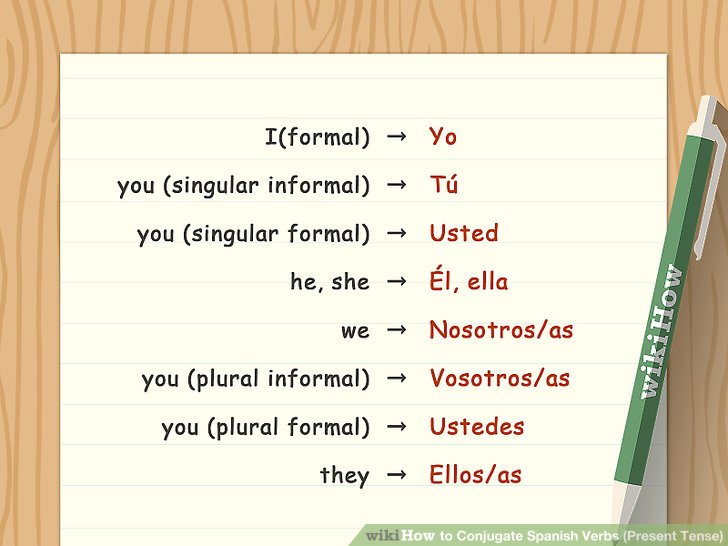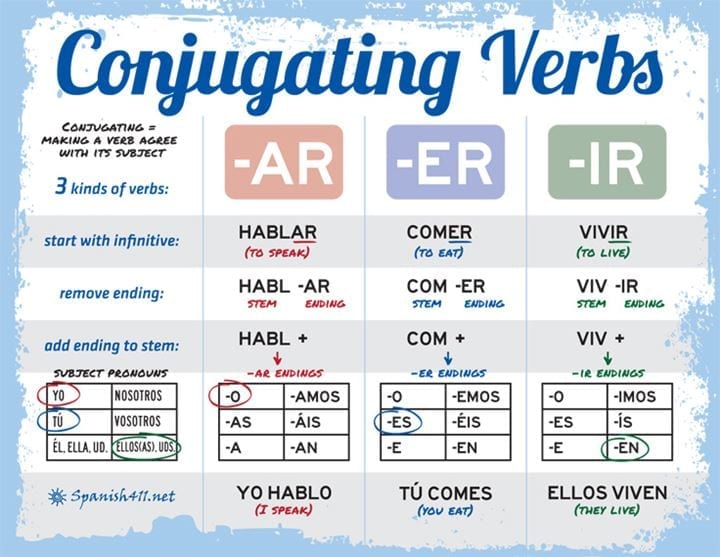Click to see all conjugation charts of saber in every tense
In this conjugation lesson we are going to learn how to conjugate the verb saber in the Presente tense of the Indicativo mood. It means we will see step by step how to create and translate forms of each grammatical person.
This lesson is specifically about the saber verb conjugation. For a general overview of all the Simple Tenses conjugation check the Simple Tenses Conjugation Chart.
You may also see this Video Presentation on how to conjugate verbs in Presente. It’s embedded below, but using the above link you will get more detailed information on conjugation in this tense as well as explanation of exceptions and special cases.
How to translate Presente to English
Note that the phrases in English provided below next to each conjugation are not direct translations from Spanish to English. They are usually the closest general equivalents. The example differences are:- In Spanish conjugation, there is the form usted in the third person singular. But this person does not translate to the English third person singular. It translates to the so called formal you and uses the inflected form which is most often represented as he/she/it in English conjugation charts.
- Similar situation happens in the third person plural, where ustedes translates to the English plural formal you but uses the form which corresponds to the they form in English.
- Tenses are used differently in Spanish and English, so the actual translation should always take into account the context and focus on translating the meaning, not just words.
- In both languages each verb may have multiple meanings and not every meaning translates directly to the other language. Here also, the context and focusing on the particular meaning helps to create the most accurate translation.
Note the timeline
The ability to correctly locate the desired position on the timeline is a crucial skill for proper choice of tenses. So note the timeline in our lessons and visualize it while speaking, listening, writing and reading. After a bit practice you will be able to select the right tense to use much easier.
Step by step instructions
Presente belongs to the simple tenses group, which means that all of the conjugated forms are one word long. There are also compound (compuesto) tenses in the Spanish language, where each conjugated form consists of two words.The verb saber has an almost entirely regular conjugation in the Presente tense of the Indicativo mood. An exception is the first person singular, which has an irregular form. It means that the other persons simply follow the general rules for this conjugation group (-er) without further exceptions, spelling corrections and the like. The basis for this conjugation is the stem of the verb, so we have to start by splitting the infinitive into a stem and an ending. It’s easy to do. Simply remove two letters from the end of the infinitive and you have the ending — one of -ar, -er or -ir. What’s left is the stem. So for our verb:- the stem is: sab-
- and the ending is: -er
- yo sé – I know
- tú sabes – you know
- él sabe – he knows
- ella sabe – she knows
- usted sabe – (formal) you know
- nosotros sabemos – we know
- nosotras sabemos – (feminine) we know
- vosotros sabéis – (plural) you know
- vosotras sabéis – (feminine, plural) you know
- ellos saben – they know
- ellas saben – (feminine) they know
- ustedes saben – (formal, plural) you know
This is it! The conjugation is now finished. That’s the final result:
| yo | sé | I know |
| tú | sabes | you know |
| él/ella/usted | sabe | he/she/it knows |
| nosotros/nosotras | sabemos | we know |
| vosotros/vosotras | sabéis | you know |
| ellos/ellas/ustedes | saben | they know |
But do not end your session yet – it’s important to repeat and practice the material in order to remember it. Check below for and next steps.
Example sentences
No sé si votaré a alguien en estas elecciones.
I do not know if I will vote for anyone in this election.
- ¿Dónde estaba tu gato en ese momento?
- Estaría en casa, pero no lo sé.
- Estaría en casa, pero no lo sé.
- Where was your cat at that moment?
- It was probably at home, but I don't know.
- It was probably at home, but I don't know.
Si sabes contar cuenta conmigo.
If you know how to count, count on me.
Voy a pagar hasta el último centavo por lo que quiero, y sé muy bien qué es lo que quiero.
I will pay every penny for what I want, and I know very well what I want.
¿Sabes de algún sitio bueno donde podamos tomar una copa esta noche?
Do you know any good place where we can have a drink tonight?
Lo malo es que ella no sabe la verdad.
The bad thing is that she doesn't know the truth.
No sé qué habría hecho si no hubieras contestado.
I don't know what I would have done if you had not answered.
Sabes que no entiendo nada que se relacione con la filosofía.
You know I do not understand anything that is related to philosophy.
Tengo demasiadas cosas para hacer así que no sé si podré ir a la fiesta.
I have too much stuff to do so I do not know if will be able to go to the party.
Cuando uno dice que sabe lo que es la felicidad, se puede suponer que la ha perdido.
When one says they know what happiness is, it can be assumed that they lost it.
Next Steps to Perfection
|
Report a mistake | Give feedback
Thank you very much for making the effort to contact us!
We strive to provide the highest quality content and we greatly appreciate even the smallest suggestions:
We strive to provide the highest quality content and we greatly appreciate even the smallest suggestions:



